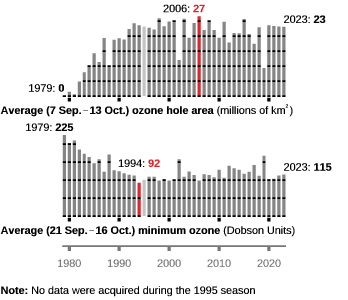Note the dog that didn't bark in the story below. No mention of what effect the CFC levels actually had on the ozone layer. It is implied that the ozone levels dropped as the CFC levels dropped but no actual ozone levels are given.
The fact is that the oxone levels do NOT follow the CFC levels. One would think that the diminishing levels of CFCs would lead to a steadily diminishing ozone hole. Nothing of the kind has happened. In terms of Dobson units, the ozone hole was at it smallest in 1994 and at its highest during this century in 2019: No progress at all and completely opposite of what the theory would lead us to expect
From the graph below one can see that the post 1994 picture is one of random fluctualions up and down with essentially no trend, though a RISING trend could possibly be fitted

NASA Ozone Watch
The global increase in ozone-depleting chlorofluorocarbon-11 (CFC-11) emissions, which was first detected in 2013 and continued to rise in the following years, appears to have been halted.
Data from monitoring stations in South Korea (AGAGE station), Japan (NIES), and Hawaii (NOAA), showed that global CFC-11 emissions began dropping in 2019, after inexplicably surging between 2014-17, according to two research papers published in Nature today.
And preliminary data from late 2019 and early 2020 shows the atmospheric CFC-11 concentration decline during that period was "the fastest since measurements began".
"The increase [in atmospheric CFC-11] we noticed and announced in 2018 was the most surprising thing I'd seen in 30 years of my work here at NOAA (National Oceanic and Atmospheric Administration)," lead author of the first paper, Stephen Montzka from NOAA said.
"To tell the truth, these new results were a close second."
The rapid turnaround of a trend that could have seen further damage to the ozone layer is reassuring evidence that the Montreal Protocol is working as intended, said researcher Luke Western from the University of Bristol, the lead author of the second paper.
"It's pleasing to see that the mechanisms of the Montreal Protocol … enabled a rapid and effective response to its first major violation."
The Montreal Protocol was an international agreement made in 1987 to phase out the use of ozone-depleting substances (ODS), principally CFCs used as propellants in things like aerosol sprays, as refrigerants in fridges and freezers, and as blowing agents for foams.
Globally, CFCs including CFC-11 — the second most commonly used chlorofluorocarbon — were completely banned in 2010, after which point researchers expected to see rapid declines in atmospheric levels, according to Dr Montzka. "The Montreal Protocol phased out CFC production in developed countries in the '90s," he said.
"It was post-2010 where we expected it to drop off more rapidly and it didn't, which raised our suspicions."
By analysing the chemical signals from their monitoring stations and combining that with a knowledge of atmospheric circulation, researchers were able to pinpoint the source of around 60 per cent of the new CFC emissions to north-eastern mainland China.
It was suspected that the CFCs were mostly used illegally in the manufacture of closed-cell foams.
Using the leverage of the Montreal Protocol, combined with scientific knowledge and industry expertise, China was asked to crack down on the source of emissions, according to Dr Western.
"In 2018 and 2019, Chinese authorities discovered small quantities of manufactured CFCs and confirmed seizures of the chemicals and closure of factories," he said.
Those reported seizures amounted to tens of tonnes. While not enough in itself to explain the 26 per cent drop in emissions between 2018 and 2019, the message sent by China's crackdown may have had the desired effect on illegal manufacturing.
Although the manufacture of CFCs was banned in 2010, there is what is called a global "bank" of chlorofluorocarbons that will continue to produce emissions into the future, even if our use of new CFCs is zero.
The CFC bank refers to the CFCs already contained in products like refrigerants and foams and which will continue to leak into the atmosphere until their end of life, according to Paul Krummel from the CSIRO.
https://www.abc.net.au/news/science/2021-02-11/ozone-layer-recovery-on-track-cfcs-surge-reversed/13131648
 --
--
No comments:
Post a Comment
All comments containing Chinese characters will not be published as I do not understand them